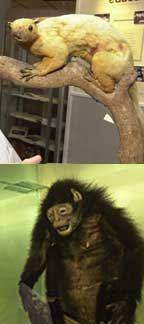
wild
places | wild happenings | wild
news
make a difference for our wild places
home | links | search the site
make a difference for our wild places
home | links | search the site
 |
wild
places | wild happenings | wild
news
make a difference for our wild places home | links | search the site |
| all articles latest | past | articles by topics | search wildnews |
|
wild
news on wildsingapore
|
| The
Straits Times 8 Apr 02 Going... Going... Gone? Urbanisation could mean the end of two breeds of mammals unique to Singapore, once common in the rainforests here By Chang Ai-Lien THERE are two mammals found only in Singapore, and soon, they could disappear forever.  Giant
in stature but small in population, the cream-coloured giant squirrel (top
picture) can weigh about 1 kg and be close to 1 meter long. There is also
a slim chance of survival for the pot-bellied banded leaf monkey (bottom
picture), which is distinguished by its ebony fur. Giant
in stature but small in population, the cream-coloured giant squirrel (top
picture) can weigh about 1 kg and be close to 1 meter long. There is also
a slim chance of survival for the pot-bellied banded leaf monkey (bottom
picture), which is distinguished by its ebony fur. The gentle banded leaf monkey and shy cream- coloured giant squirrel were so common 40 years ago they often ended up in cooking pots. Now, they are so rare, there is not a single photograph of them in the wild. While the squirrel looks set to vanish, the monkey has a slim chance of defying the odds. Urbanisation, which has led to them losing their habitat, is the major reason for their diminishing numbers. The giant squirrel was first discovered by Sir Stamford Raffles in 1819, who said it was 'abundantly present in the woods'. Now, Associate Professor Peter Ng said: 'It is finished. I estimate it'll be gone in 10 years.' Only four have been spotted sporadically in the central catchment area over the last 10 years. Just 30 years ago, when he was a boy, Prof Ng was given one as a pet. 'It wasn't very good-tempered as it was meant to be in the wild,' the director of the Raffles Museum of Biodiver- sity Research, which studies the flora and fauna of South-east Asia, recalled sadly. The disappearance of such native animals, he added, is symbolic of a bigger problem - the loss of substantial parts of the primary rainforests and other possible wildlife habitats, through development and urbanisation. 'Our primary forests are now like patients in intensive care. Take away human intervention, such as re-afforestation, and they will die.' Meanwhile, the National Parks Board (NParks) has been keeping a close watch on the two disappearing creatures. Said an NParks spokesman: 'Our wildlife management and conservation strategy includes monitoring their behaviour, feeding and breeding patterns, roosting sites, troop size and where they're usually spotted.' She added that the board is also taking steps to protect their habitat by restoring it. Explaining how tiny Singapore could be home to such unique creatures, Prof Ng said: 'If you isolate any group of individuals long enough, they'll develop their own set of characteristics.' If they are so rare and precious, why not capture and breed them in the zoo? He explained that apart from their small numbers and shyness making them extremely hard to catch in the wild, very little is known about them. 'It's a catch-22 situation. If we do catch them, we'll be taking away what few exist in the wild, and what if they don't do well in captivity?' To see these elusive animals, visit the Raffles Museum of Biodiversity Research at the National University of Singapore, which has stuffed specimens. Rare Singapore monkeys and squirrels on verge of extinction, scientist says Associated Press SINGAPORE April 9 - Giant cream-coloured squirrels and potbellied monkeys - once so common in Singapore that they were eaten for dinner - are almost extinct and have little hope of being saved, a wildlife expert said Monday. Both animals are native to Singapore, and the tiny Southeast Asian city-state is believed to be the only place in the world where they are found, said Peter Ng, director of the Raffles Museum of Biodiversity. The potbellied banded leaf monkey has a chance of being saved, but the squirrel looks set to disappear forever, Ng told The Associated Press. Optimists say there are four of the squirrels justify in the wild and pessimists say there are just two, Ng said. The squirrels ``could be gone even now,'' he said. ``With the population that size, even if they are breeding, it will mean that there's so much inbreeding that the chance of them surviving is next to nil.'' Singapore's rapid urbanization has destroyed most of the primary rain forest where the animals lived. There are about 20 of the monkeys justify in Singapore, Ng said. He said the monkeys' only hope for survival would be finding a genetic match with a group of similar monkeys in neighboring Malaysia. But chances of finding a match were slim because the Malaysian monkeys are believed to be of a different subspecies, he said. Ng ruled out cloning to save the squirrels and monkeys. ``As far as I'm concerned, that's mainly science fiction,'' he said. ``Even if you succeed, at phenomenal cost, what are you going to do with the descendants? Their natural habitat is gone, and the forests are too small to sustain large populations.'' - AP links Related articles on Singapore's biodiversity status, threats, commercial applications of biodiversity |
| News articles are reproduced for non-profit educational purposes. | |
website©ria tan 2003 www.wildsingapore.com |